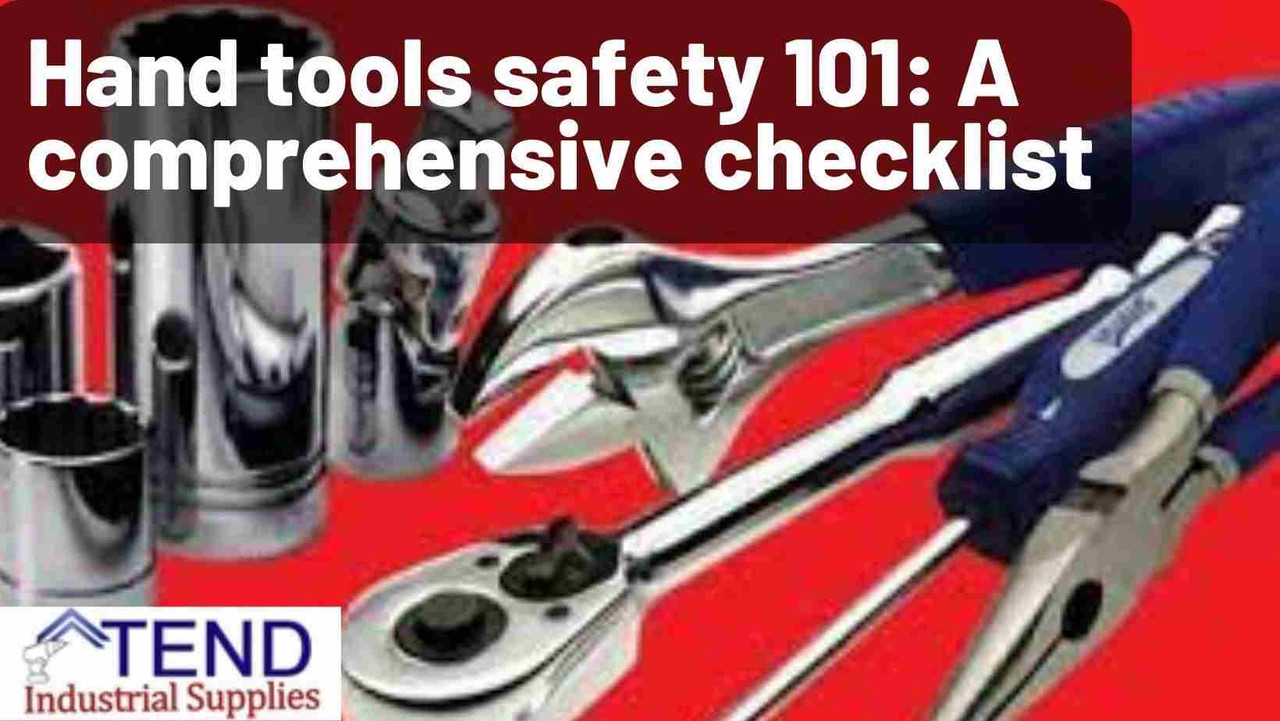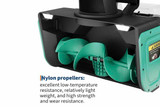Hand tools safety 101: A comprehensive checklist
Hand tools safety 101
At Tend Industrial Supplies, we understand that your safety is paramount when working with hand tools. Whether you're a professional craftsman or a DIY enthusiast, mastering hand tool safety is crucial for preventing workplace accidents and ensuring project success. This comprehensive guide will walk you through essential safety practices, provide practical tips, and help you create a safer working environment with your hand tools. With our extensive selection of high-quality hand tools and safety equipment, we're committed to not just selling tools, but ensuring you know how to use them safely and effectively.
Key Takeaways:
- Always choose the right tool for the job from a reputable supplier like Tend Industrial Supplies
- Regular inspection and maintenance of your hand tools extends their life and ensures safety
- Proper PPE is non-negotiable when working with hand tools
- Understanding specific safety guidelines for each tool type prevents accidents
- Following manufacturer instructions and proper usage techniques maximizes tool effectiveness
A. Importance of Hand Tool Safety
Hand tool safety is paramount for anyone who uses tools, whether for professional purposes or DIY projects. Properly using and maintaining hand tools are essential to prevent accidents and injuries and ensure a safe working environment. Understanding the importance of hand tool safety is the first step towards fostering a culture of responsibility and caution when handling tools is what this article is about
B. Overview of Common Hazards
Hand tools, if misused, can pose several hazards. These include cuts, abrasions, punctures, and even more severe injuries such as fractures and amputations. Additionally, using damaged or defective tools can increase the risk of accidents. Awareness of these common hazards is crucial for adopting preventive measures and ensuring safe tool usage.
C. Objective of the Comprehensive Checklist
The objective of this comprehensive checklist is to provide users with a set of guidelines and safety tips for using hand tools effectively and safely. By adhering to these guidelines, users can minimize the risk of injuries and create a safer working environment, whether at home or on a job site.
General Safety Tips for Hand Tools
A. Proper Tool Selection
- Choosing the Right Tool for the Job
- Selecting the appropriate tool for the task at hand is fundamental to safety. Using the wrong tool can lead to accidents and damage to the workpiece. Ensure the tool is designed for the specific job and is of the correct size and type.
- Considering Ergonomic Design
- Ergonomically designed tools reduce the strain on the user’s body and enhance comfort and efficiency. Look for tools with comfortable grips, appropriate weight, and designs that minimize hand and wrists stress.
B. Regular Inspection and Maintenance
- Checking for Damages
- Regularly inspect tools for any signs of wear, damage, or defects. Damaged tools are more likely to fail and cause accidents. Discard or repair tools with cracks, chips, or other defects before use.
- Proper Tool Maintenance
- Keeping tools well-maintained extends their lifespan and ensures safe operation. Clean tools after use, lubricate moving parts, and store them in a dry, secure place to prevent rust and deterioration.
C. Correct Usage of Tools
- Following Manufacturer’s Instructions
- Always follow the manufacturer’s instructions for using, maintaining, and storing tools. These instructions provide valuable information on the tool’s capabilities, limitations, and safety precautions.
- Avoiding Improper Use
- Never use tools for purposes they were not designed for. Avoid using a screwdriver as a chisel or a wrench as a hammer, as this can lead to tool damage and increase the risk of injury.
D. Personal Protective Equipment (PPE)
- Importance of Wearing PPE
- Wearing appropriate Personal Protective Equipment (PPE) is essential for protecting against injuries. PPE acts as a barrier between the user and potential hazards, reducing the risk of harm.
- Types of PPE for Different Tools
- Depending on the tool and task, different types of PPE may be required. This includes safety gloves, goggles, ear protection, and more. Ensure the PPE suits the specific tool and task, and wear it consistently.
Users can significantly reduce the risk of accidents and injuries by following these general safety tips and understanding the importance of hand tool safety. The comprehensive checklist is valuable for fostering safe practices and promoting responsible tool usage.
Specific Safety Guidelines for Common Hand Tools
| Hand Tool | Common Hazards | Preventive Measures |
| Hammer | Flying debris | Wear safety glasses |
| Hammer | Misstrikes | Use the right size and type of hammer |
| Hammer | Hammer rebound | Strike squarely and avoid glancing blows |
| Screwdriver | Slipping off screws | Ensure tip and screw match |
| Screwdriver | Over-torquing | Apply steady, even pressure |
| Screwdriver | Using as pry bar | Use the tool only for its intended purpose |
| Pliers | Pinching hands | Use the right type of pliers |
| Pliers | Slipping off objects | Ensure proper locking and gripping |
| Wrenches | Over-extension | Avoid using excessive force |
| Wrenches | Slipping off nuts/bolts | Position the wrench securely |
| Saws | Cuts and lacerations | Use safe cutting techniques |
| Saws | Blade breakage | Regularly inspect and replace blades |
| Chisels | Hand injuries | Wear hand protection |
| Chisels | Flying chips of material | Strike properly with a mallet or hammer |
| Utility Knives | Cuts and punctures | Handle blades carefully and replace when dull |
| Utility Knives | Retraction failure | Always retract the blade when not in use |
A. Hammers
- Proper Grip and Handling
- Holding the hammer correctly and maintaining a firm grip is essential to prevent slipping and ensure accurate strikes. Always grip the handle, not the shaft, and keep your wrist straight during use.
- Striking Techniques
- Strike the surface squarely to avoid glancing blows and potential injuries. Never use a hammer with a loose or damaged handle; always wear eye protection to guard against flying debris.
B. Screwdrivers
- Ensuring Tip and Screw Match
- Using the correct tip size and type for the screw is crucial to prevent slipping and stripping. Ensure the screwdriver tip fully engages with the screw head to avoid accidents.
- Avoiding Over-torquing
- Apply steady, even pressure when turning a screwdriver to avoid over-torquing and damaging the screw or tool. Never use a screwdriver as a pry bar or chisel.
C. Pliers
- Using the Right Type of Pliers
- Select the appropriate type of pliers for the task, whether needle-nose, slip-joint, or locking pliers, to ensure proper gripping and handling.
- Ensuring Proper Locking and Gripping
- Ensure pliers are locked securely when in use and that the gripping surface is clean and free of oil or grease to prevent slipping.
D. Wrenches
- Avoiding Over-extension
- Do not use excessive force or extend the length of the wrench handle for additional leverage, as this can lead to tool damage and injury.
- Proper Positioning
- Position the wrench securely on the nut or bolt and pull rather than push to avoid slipping and potential injuries.
E. Saws
- Safe Cutting Techniques
- Use smooth, controlled strokes when cutting and ensure the material being cut is secured. Keep hands and fingers away from the blade and wear appropriate PPE.
- Blade Safety
- Regularly inspect saw blades for damage and sharpness. Replace dull or damaged blades promptly to prevent accidents and ensure efficient cutting.
F. Chisels
- Hand Protection
- Always wear hand protection when using chisels to prevent cuts and punctures. Hold the chisel securely and keep your hands behind the cutting edge.
- Proper Striking
- Strike the chisel with a mallet or hammer squarely to avoid glancing blows. Never use a damaged chisel or one with a mushroomed head.
G. Utility Knives
- Blade Handling and Replacement
- Handle blades with care and replace them promptly when dull. Always retract the blade when not in use and store the knife securely.
- Safe Cutting Practices
- Cut away from your body and keep hands and fingers clear of the cutting path. Use a cutting mat or suitable surface to protect the work area.
Ready to upgrade your hand tools with safety in mind? Visit Tend Industrial Supplies today at www.tendsupplies.com to explore our comprehensive selection of professional-grade hand tools and essential safety equipment. Don't compromise on quality when it comes to workplace safety. Contact our expert team at [link to contact page] for personalized recommendations on the safest and most efficient tools for your specific needs. Remember, investing in quality tools is investing in your safety. Shop now and save on your next purchase with our current safety equipment promotions!
Readers like:
A Guide to the Best Quality Hand Tools for Every BudgetIntroduction to Hand Tools: Definition, Importance, and Classifications
Classification and Importance of Hand Tools: A Deep Dive
Types of Hand Tools for Every Job and Every Workshop
Advanced Hand Tools: A Deep Dive into Specialized Workshop Equipment
Innovative Workshop Tools of 2023: High-Tech Hand Tools Making a Difference
Comparing Electric and Manual Hand Tools: What Every Workshop Needs








